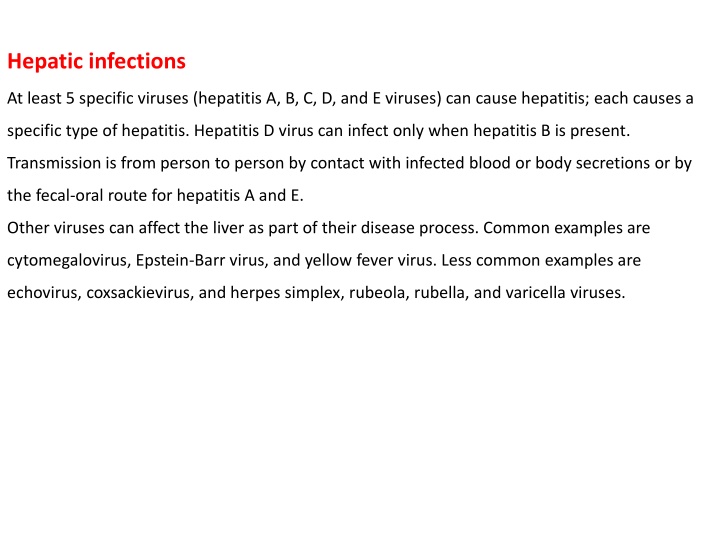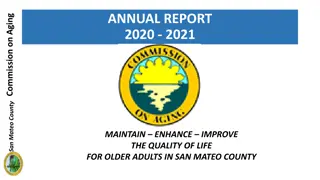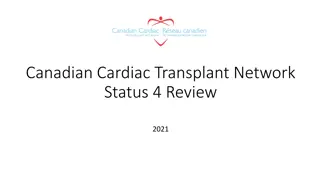
Acute Viral Hepatitis and Hepatic Infections
Explore the world of acute viral hepatitis and hepatic infections caused by specific viruses like hepatitis A, B, C, D, and E. Learn about transmission, symptoms, phases, and more in this comprehensive guide.
Download Presentation

Please find below an Image/Link to download the presentation.
The content on the website is provided AS IS for your information and personal use only. It may not be sold, licensed, or shared on other websites without obtaining consent from the author. If you encounter any issues during the download, it is possible that the publisher has removed the file from their server.
You are allowed to download the files provided on this website for personal or commercial use, subject to the condition that they are used lawfully. All files are the property of their respective owners.
The content on the website is provided AS IS for your information and personal use only. It may not be sold, licensed, or shared on other websites without obtaining consent from the author.
E N D
Presentation Transcript
Hepatic infections At least 5 specific viruses (hepatitis A, B, C, D, and E viruses) can cause hepatitis; each causes a specific type of hepatitis. Hepatitis D virus can infect only when hepatitis B is present. Transmission is from person to person by contact with infected blood or body secretions or by the fecal-oral route for hepatitis A and E. Other viruses can affect the liver as part of their disease process. Common examples are cytomegalovirus, Epstein-Barr virus, and yellow fever virus. Less common examples are echovirus, coxsackievirus, and herpes simplex, rubeola, rubella, and varicella viruses.
Overview of Acute Viral Hepatitis Acute viral hepatitis is diffuse liver inflammation caused by specific hepatotropic viruses that have diverse modes of transmission and epidemiologies. A nonspecific viral prodrome is followed by anorexia, nausea, and often fever or right upper quadrant pain. Jaundice often develops, typically as other symptoms begin to resolve. Most cases resolve spontaneously, but some progress to chronic hepatitis. Occasionally, acute viral hepatitis progresses to acute liver failure (indicating fulminant hepatitis).
Characteristic Family Hepatitis A Virus Picornaviridae Hepatitis B Virus Hepadnaviridae Hepatitis C Virus Flaviviridae Hepatitis D Virus unclssified Hepatitis E Virus Hepeviridae Nucleic acid Serologic diagnosis Major transmission Incubation period (days) Epidemics Chronicity Liver cancer RNA IgM anti-HA DNA HBsAg RNA Anti-HCV * Anti-HDV RNA Anti-HEV Fecal-oral Blood Blood Needle Water 15 45 40 180 20 120 30 180 14 60 Yes No No No Yes Yes No Yes Yes No Yes Yes Yes No No *Incomplete RNA; requires presence of hepatitis B virus for replication. Anti-HCV = antibody to hepatitis C virus; anti-HDV = antibody to hepatitis D virus; anti-HEV = antibody to hepatitis E virus; HBsAg = hepatitis B surface antigen; IgM anti-HAV = IgM antibody to hepatitis A virus.
Symptoms and Signs Some manifestations of acute hepatitis are virus-specific, but in general, acute infection tends to develop in predictable phases: Incubation period: The virus multiplies and spreads without causing symptoms. Prodromal (pre-icteric) phase:Nonspecific symptoms occur; they include profound anorexia, malaise, nausea and vomiting, and often fever or right upper quadrant abdominal pain. Urticaria and arthralgias occasionally occur, especially in HBV infection. Icteric phase: After 3 to 10 days, the urine darkens, followed by jaundice. Systemic symptoms often regress, and patients feel better despite worsening jaundice. The liver is usually enlarged and tender, but the edge of the liver remains soft and smooth. Mild splenomegaly occurs in 15 to 20% of patients. Jaundice usually peaks within 1 to 2 wk. Recovery phase: During this 2- to 4-wk period, jaundice fades. Acute viral hepatitis usually resolves spontaneously 4 to 8 wk after symptom onset. Anicteric hepatitis (hepatitis without jaundice) occurs more often than icteric hepatitis in patients with HCV infection and in children with HAV infection. It typically manifests as a minor flu-like illness.
Serology In patients with findings suggesting acute viral hepatitis, the following studies are done to screen for hepatitis viruses A, B, and C: IgM antibody to HAV (IgM anti-HAV) Hepatitis B surface antigen (HBsAg) IgM antibody to hepatitis B core (IgM anti-HBc) Antibody to HCV (anti-HCV) If any are positive, further serologic testing may be necessary to differentiate acute from past or chronic infection. If serology suggests hepatitis B, testing for hepatitis B e antigen (HBeAg) and antibody to hepatitis B e antigen (anti-HBe) is usually done to help determine the prognosis and to guide antiviral therapy. If serologically confirmed HBV infection is severe, anti-HDV is measured. If the patient has recently traveled to an endemic area, IgM antibody to HEV (IgM anti-HEV) should be measured if the test is available.
Treatment Supportive care No treatments attenuate acute viral hepatitis. Prevention Because treatments have limited efficacy, prevention of viral hepatitis is very important. Immunoprophylaxis can involve active immunization using vaccines and passive immunization. Vaccines for hepatitis A and hepatitis B and hepatitis E are available . General measures Good personal hygiene helps prevent transmission, particularly fecal-oral transmission, as occurs with HAV and HEV. Blood and other body fluids (eg, saliva, semen) of patients with acute HBV and HCV infection and stool of patients with HAV infection are considered infectious. Posttransfusion infection is minimized by avoiding unnecessary transfusions and screening all donors for HBsAg and anti- HCV. Screening has decreased the incidence of posttransfusion hepatitis, probably to about 1/100,000 units of blood component transfused.
Overview of Chronic Hepatitis Chronic hepatitis is hepatitis that lasts > 6 mo. Many patients have no history of acute hepatitis, and the first indication is discovery of asymptomatic aminotransferase elevations. Some patients present with cirrhosis or its complications (eg, portal hypertension). Biopsy is necessary to confirm the diagnosis and to grade and stage the disease. .Etiology Hepatitis B virus (HBV) and hepatitis C virus (HCV) are frequent causes of chronic hepatitis; 5 to 10% of cases of HBV infection, with or without hepatitis D virus (HDV) coinfection, and about 75% of cases of HCV infection become chronic. Rates are higher for HBV infection in children (eg, up to 90% of infected neonates and 30 to 50% of young children). Symptoms and Signs Clinical features of chronic hepatitis vary widely. About one third of cases develop after acute hepatitis. Many patients are asymptomatic, especially in chronic HCV infection. However, malaise, anorexia, and fatigue are common, sometimes with low-grade fever and nonspecific upper abdominal discomfort. Jaundice is usually absent. Often, particularly with HCV, the first findings are Signs of chronic liver disease Complications of cirrhosis Chronic HCV is occasionally associated with dermal and renal symptoms (due to immune complexes diseases) and, perhaps, non-Hodgkin B-cell lymphoma.
Hepatitis A, Acute Hepatitis A virus (HAV) is a single-stranded RNA picornavirus. It is the most common cause of acute viral hepatitis and is particularly common among children and young adults. HAV spreads primarily by fecal-oral contact and thus may occur in areas of poor hygiene. Waterborne and food- borne epidemics occur, especially in developing countries. Fecal shedding of the virus occurs before symptoms develop and usually ceases a few days after symptoms begin; thus, infectivity often has already ceased when hepatitis becomes clinically evident. Symptoms and Signs In children < 6 yr, 70% of hepatitis A infections are asymptomatic, and in children with symptoms, jaundice is rare. In contrast, most older children and adults have typical manifestations of viral hepatitis, including anorexia, malaise, fever, nausea, and vomiting; jaundice occurs in over 70%. Manifestations typically resolve after about 2 mo, but in some patients, symptoms continue or recur for up to 6 mo. Recovery from acute hepatitis A is usually complete. Diagnosis IgM antibody to HAV (IgM anti-HAV) If the IgM anti-HAV test is positive, acute hepatitis A is diagnosed. The IgG antibody to HAV (IgG anti-HAV) test is done to help distinguish acute from prior infection. A positive IgG anti-HAV test suggests prior HAV infection or acquired immunity.
Hepatitis B, Acute HBV is the 2nd most common cause of acute viral hepatitis. Prior unrecognized infection is common but is much less widespread than that with hepatitis A virus. HBV, for unknown reasons, is sometimes associated with several primarily extrahepatic disorders may be due to autoimmune mechanisms. Transmission - HBV is often transmitted parenterally, typically by contaminated blood or blood products. - Risk of HBV is increased for patients in renal dialysis and oncology units and for hospital personnel in contact with blood. - Infants born to infected mothers have a 70 to 90% risk of acquiring hepatitis B during delivery unless they are treated with hepatitis B immune globulin (HBIG) and are vaccinated immediately after delivery. Earlier transplacental transmission can occur but is rare. - The virus may be spread through mucosal contact with other body fluids (eg, between sex partners, both heterosexual and homosexual; in closed institutions, such as mental health institutions and prisons), but infectivity is far lower than that of hepatitis A virus, and the means of transmission is often unknown. - Many cases of acute hepatitis B occur sporadically without a known source.
Symptoms and Signs Hepatitis B infection causes a wide spectrum of liver diseases, from a subclinical carrier state to severe hepatitis or acute liver failure (fulminant hepatitis), particularly in the elderly, in whom mortality can reach 10 to 15%. Most patients have typical manifestations of viral hepatitis, Symptoms persist from a few weeks up to 6 mo. Five to 10% of all patients with HBV develop chronic hepatitis B or become inactive carriers. The younger the age when acute infection occurs, the higher the risk of developing chronic infection: For infants: 90% For children aged 1 to 5 yr: 25 to 50% Adults: About 5% Cirrhosis can develop. Hepatocellular carcinoma can ultimately develop in chronic HBV infection, even without being preceded by cirrhosis.
Diagnosis If acute viral hepatitis is suspected, the following tests are done to screen for hepatitis B viruses : Hepatitis B surface antigen (HBsAg) IgM antibody to hepatitis B core (IgM anti-HBc) If any of the hepatitis B tests are positive, further serologic testing may be necessary to differentiate acute from past or chronic infection. Hepatitis B has at least 3 distinct antigen-antibody systems that can be tested: 1- HBsAg characteristically appears during the incubation period, usually 1 to 6 wk before clinical or biochemical illness develops, and implies infectivity of the blood. It disappears during convalescence. However, HBsAg is occasionally transient. The corresponding protective antibody (anti-HBs) appears weeks or months later, after clinical recovery, and usually persists for life; thus, its detection indicates past HBV infection and relative immunity. In 5 to 10% of patients, HBsAg persists and antibodies do not develop; these patients become asymptomatic carriers of the virus or develop chronic hepatitis.
2- HBcAg reflects the viral core. It is detectable in infected liver cells but not in serum except by special techniques. Antibody to HBcAg (anti-HBc) usually appears at the onset of clinical illness; thereafter, titers gradually diminish, usually over years or life. Its presence with anti-HBs indicates recovery from previous HBV infection. Anti-HBc is also present in chronic HBsAg carriers, who do not mount an anti-HBs response. In acute infection, anti-HBc is mainly of the IgM class, whereas in chronic infection, IgG anti-HBc predominates. IgM anti-HBc is a sensitive marker of acute HBV infection and occasionally is the only marker of recent infection, reflecting a window between disappearance of HBsAg and appearance of anti-HBs. 3- HBeAg is a protein derived from the viral core. Present only in HBsAg-positive serum, HBeAg tends to suggest more active viral replication and greater infectivity. In contrast, presence of the corresponding antibody (anti-HBe) suggests lower infectivity. Thus, e antigen markers are more helpful in prognosis than in diagnosis. HBV-DNA can be detected in the serum of patients with active HBV infection.
Hepatitis B Serology* Prior HBV Infection Marker Acute HBV Infection Chronic HBV Infection HBsAg Anti-HBs IgM anti-HBc IgG anti-HBc HBeAg Anti-HBe HBV-DNA + + + + + + + *Antibody to hepatitis D virus (anti-HDV) levels should be measured if serologic tests confirm HBV and infection is severe. Patients have had HBV infection and recovered. Anti-HBs is also seen as the sole serologic marker after HBV vaccination. Anti-HBc = antibody to hepatitis B core; anti-HBe = antibody to HBeAg; anti-HBs = antibody to HBsAg; HBeAg =hepatitis B e antigen; HBsAg = hepatitis B surface antigen; HBV = hepatitis B virus.
Hepatitis B, Chronic Hepatitis B is a common cause of chronic hepatitis. Patients may be asymptomatic or have nonspecific manifestations such as fatigue and malaise. Without treatment, cirrhosis often develops; risk of hepatocellular carcinoma is increased. Antiviral drugs may help, but liver transplantation may become necessary. Hepatitis lasting > 6 mo is generally defined as chronic hepatitis, although this duration is arbitrary. However, the younger the age when acute infection occurs, the higher the risk of developing chronic infection: For infants: 90% For children aged 1 to 5 yr: 25 to 50% Adults: About 5% Without treatment, chronic hepatitis B can resolve (uncommon), progress rapidly, or progress slowly to cirrhosis over decades. Resolution often begins with a transient increase in disease severity and results in seroconversion from hepatitis B e antigen (HBeAg) to antibody to hepatitis B e antigen (anti-HBe). Coinfection with hepatitis D virus (HDV) causes the most severe form of chronic HBV infection; without treatment, cirrhosis develops in up to 70% of patients. Chronic HBV infection increases the risk of hepatocellular cancer.
Symptoms and Signs Symptoms vary depending on the degree of underlying liver damage. Many patients, particularly children, are asymptomatic. However, malaise, anorexia, and fatigue are common, sometimes with low-grade fever and nonspecific upper abdominal discomfort. Jaundice is usually absent. Often, the first findings are Signs of chronic liver disease or portal hypertension , cirrhosis, manifestations of cholestasis, extrahepatic manifestations. Diagnosis Diagnosis is confirmed by finding positive hepatitis B surface antigen (HBsAg) and IgG anti-HBc and negative IgM antibody to HBcAg (anti-HBc) and by measuring hepatitis B virus DNA (quantitative HBV-DNA). Liver biopsy
Hepatitis C, Acute Hepatitis C virus (HCV) is a single-stranded RNA flavivirus that causes acute viral hepatitis and is a common cause of chronic viral hepatitis. Six major HCV subtypes exist with varying amino acid sequences (genotypes); these subtypes vary geographically and in virulence and response to therapy. HCV can also alter its amino acid pattern over time in an infected person, producing quasispecies. HCV infection sometimes occurs simultaneously with specific systemic disorders, including the following: Essential mixed cryoglobulinemia Porphyria cutanea tarda Glomerulonephritis The mechanisms are uncertain.
Transmission of hepatitis C Infection is most commonly transmitted through blood, primarily when parenteral drug users share needles, but also through tattoos or body piercing. Sexual transmission and vertical transmission from mother to infant are relatively rare. Some sporadic cases occur in patients without apparent risk factors. HCV prevalence varies with geography and other risk factors. Symptoms and Signs Hepatitis C may be asymptomatic during the acute infection. Its severity often fluctuates, sometimes with recrudescent hepatitis and roller-coaster aminotransferase levels for many years or even decades. HCV has the highest rate of chronicity (about 75%). The resultant chronic hepatitis C is usually asymptomatic or benign but progresses to cirrhosis in 20 to 30% of patients; cirrhosis often takes decades to appear. Hepatocellular carcinoma can result from HCV-induced cirrhosis but results only rarely from chronic infection without cirrhosis (unlike in hepatitis B).
Diagnosis If acute viral hepatitis is suspected, the following tests are done to screen for hepatitis viruses A, B, and C: IgM antibody to hepatitis A virus (IgM anti-HAV) Hepatitis B surface antigen (HBsAg) IgM antibody to hepatitis B core (IgM anti-HBc) Antibody to HCV (anti-HCV) If the anti-HCV test is positive, HCV-RNA is measured to distinguish active from past hepatitis C infection. In hepatitis C, serum anti-HCV represents chronic, past, or acute infection; the antibody is not protective. In unclear cases, HCV-RNA is measured. Anti-HCV usually appears within 2 wk of acute infection but is sometimes delayed; however, HCV-RNA is positive sooner.
Hepatitis D Hepatitis D is caused by a defective RNA virus (delta agent) that can replicate only in the presence of hepatitis B virus. It occurs uncommonly as a coinfection with acute hepatitis B or as a superinfection in chronic hepatitis B. Hepatitis D is usually transmitted by parenteral or mucosal contact with infected blood or body fluids. Infected hepatocytes contain delta particles coated with hepatitis B surface antigen (HBsAg). Prevalence of hepatitis D virus (HDV) varies widely geographically, with endemic pockets in several countries. Parenteral drug users are at relatively high risk, but HDV, unlike hepatitis B virus (HBV) has not widely permeated the homosexual community. Symptoms and Signs Acute hepatitis D infection typically manifests as Unusually severe acute HBV infection (coinfection) An acute exacerbation in chronic HBV carriers (superinfection) A relatively aggressive course of chronic HBV infection Diagnosis If serologic tests for hepatitis B confirm infection and clinical manifestations are severe, antibody to HDV (anti-HDV) levels should be measured. Anti-HDV implies active infection. It may not be detectable until weeks after the acute illness.
Hepatitis E Hepatitis E is caused by an enterically transmitted RNA virus and causes typical symptoms of viral hepatitis, including anorexia, malaise, and jaundice. Fulminant hepatitis and death are rare, except during pregnancy. There are 4 genotypes of hepatitis E virus (HEV). All can cause acute viral hepatitis. Genotypes 1 and 2 usually cause waterborne outbreaks that are linked to fecal contamination of the water supply and fecal-oral person-to-person transmission. Outbreaks have epidemiologic characteristics similar to hepatitis A virus epidemics. Sporadic cases also occur. Genotypes 3 and 4 typically cause sporadic cases rather than outbreaks. Transmission is food-borne and can involve eating uncooked or undercooked meat; cases have been associated with consumption of pork, deer, and shellfish. Symptoms and Signs Typical manifestations of viral hepatitis occur. Hepatitis E may be severe, especially in pregnant women; in them, risk of fulminant hepatitis and death is increased. Diagnosis If tests for hepatitis A, B, and C are negative but the patient has typical manifestations of viral hepatitis and has recently traveled to an endemic area, IgM antibody to HEV (IgM anti-HEV) should be measured.






















